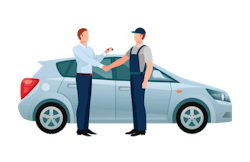Lou Delloso gets the distinct impression that many insurance companies would like him to use aftermarket parts more often. That feeling has gotten stronger in recent years.
“Lately, we’re getting more insurance companies that are pushing the aftermarket,” says Delloso, body shop director for the Bradshaw Automotive Group in South Carolina. “In the last five years, the industry has changed, to go to the aftermarket industry, because of it being quote unquote cost-effective—we hear it all day, every day.”
Delloso also feels, with the current saturation of companies in the aftermarket, that the quality of those parts can be questionable. He wants to use aftermarket parts only when the situation truly seems appropriate (for an older, well-maintained pickup, for example). And, he always wants his customers 100 percent satisfied with the parts used in their vehicle’s repair.
Delloso also knows that his facility needs to comply with insurance companies to a certain extent.
Ultimately, he handles the growing trend of insurers pushing aftermarket parts thusly: he educates his customers. Delloso, who oversees two body shops that do a combined $21 million in annual revenue, described exactly how he educates customers in a recent conversation with Fixed Ops Business.
As told to Kelly Beaton
If it was up to us, every part we put on the car would be OEM. But our hands are being forced by different insurance companies, saying, “No, you have to put an aftermarket part on this car.” Now, aftermarket parts are effective on a case-by-case situation, but it’s maybe 10 percent of the time. With aftermarket parts, mainly you have fit issues with the way they’re molded. If you bring an aftermarket part in and it doesn’t work, you have to return it, and then you have to order in an OEM part, so that’s a lot of wasted time on the customer’s side.
We explain to the customer what an aftermarket part is. We say, “this part is being made for your car, but not by the specific manufacturer.” The customer will come in with his or her estimate, and on that estimate, he or she will have “aftermarket parts,” so we educate the customer. We tell him or her we’re going to see if we can go ahead and put OEM parts on there, but it looks like the insurance company is dictating that we have to use aftermarket. So, we educate that customer to go ahead and notify the insurance company, and it’s up to the insurance company to OK that, not us.
Nowadays, many customers are knowledgeable about aftermarket parts. You know, the Internet is both an advantage and a disadvantage; education is dangerous. So, what they’re doing now is looking at these parts on the estimate indicating “aftermarket,” and some of them will be educated with it. But, when we write an estimate, we go down line by line, so the customer completely understands what process is taking place to repair the vehicle.
We explain to the customer, line by line, what everything means on the estimate. We explain what R&I means, what RPO (regular production options) means, and replacing versus removing and installing, and then indicate what type of part it is. We take the time to explain to them, so that there’s no surprise on the back end. We want to make sure that our customers are educated before we start the repair process, so we’re all totally on the same page.

